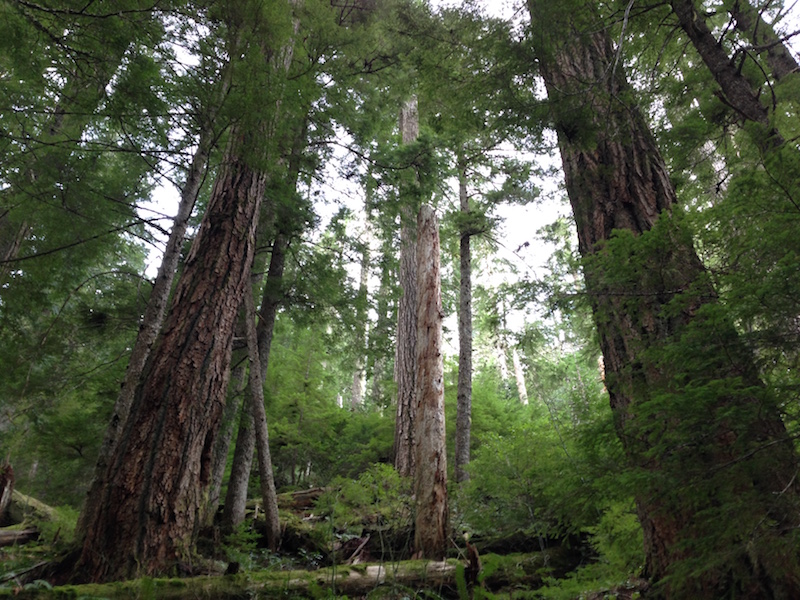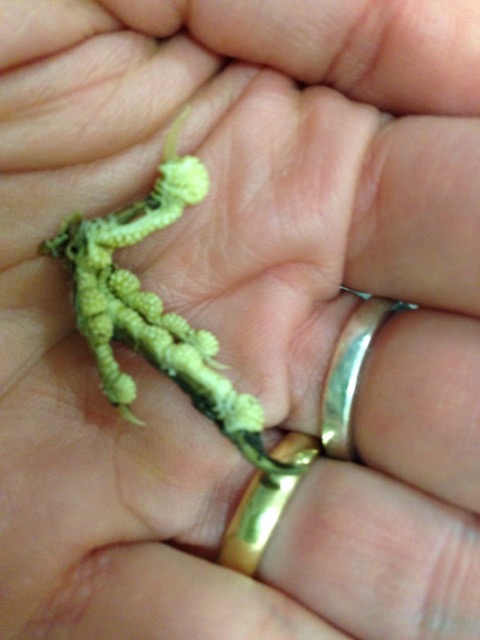
I find a stick and use it to break up the dry twists of coyote scat I have found on the trail. Shit is nature’s obituary page. In each pile are the traces of lives recently lost.
In this particular excreta I find a sprinkling of little white brittle bones—bird bones. And then I pull out a whole bird’s foot, about the size of a quarter: yellow and reptilian with three forward toes with serious looking claws, and one backward toe, higher up on the ankle, also clawed.
I email a picture to my brother in law, Vanya Rohwer, now the Curator of Birds & Mammals at Cornell University’s Museum of Vertebrates. He guesses it was a Steller’s jay or varied thrush. Then he adds, ‘The jay falling prey to a coyote seems a little dubious though—trickster vs. trickster—and i think the jay would win…. If it is a jay, perhaps the coyote found an old hawk kill and scavenged the foot.”
This all happened in January of 2015, but I often think of his phrase, “trickster vs. trickster.” Vanya meant that both species were unusually intelligent and wary, and that he found it hard to believe the clever jay could be caught by a coyote. Coyotes, of course, are mythical tricksters in the traditions of many Native American tribes. Sometimes a buffoon, sometimes a creator, always up to something, coyote actually invents death in many tales. Here, coyote invented death for jay.
Jays aren’t as well known as tricksters, but they play that role in many stories. Sometimes blue jay visits the land of the dead.
 I found the poop foot while hiking alone to a fire lookout in the Willamette National Forest in Oregon. I was at a writing residency at the HJ Andrews Experimental Forest, a site for longterm forest science. Many of the studies here reveal the importance of death and dead things in forest ecosystems. Their most famous study is in its 31st year: it tracks in meticulous detail the decomposition of logs lying on the forest floor. It is expected to take 200 years to complete.
I found the poop foot while hiking alone to a fire lookout in the Willamette National Forest in Oregon. I was at a writing residency at the HJ Andrews Experimental Forest, a site for longterm forest science. Many of the studies here reveal the importance of death and dead things in forest ecosystems. Their most famous study is in its 31st year: it tracks in meticulous detail the decomposition of logs lying on the forest floor. It is expected to take 200 years to complete.
On my first full day at the station, I toured the experimental forest with geologist Frederick Swanson, who has who had researched there for decades. He explained that among other important findings, research at HJ Andrews convinced the Forest Service that there was no need to remove dead trees and limbs to keep the forest productive and healthy, that “woody detritus” controls erosion, holds onto water like a sponge, releases a slow drip of nutrients into the soil as it rots, and functions as habitat for little life: fungi, microbes, invertebrates and so on. If you’ve spent any time in Pacific Northwest forests, you are familiar with the “nurse log”—a dead, rotting tree acting as potting soil for a young living tree. Life from death.
The night I found the bird’s foot, I dreamed that my grandmother was standing by a pond, throwing in handfuls of snow to lower its temperature. She was trying to make it freeze over.
The next day I hiked through a very old stand of trees, 500 years old many of them. When I stopped for lunch, I took out my notebook and wrote, “Thinking mostly about nothing much except how the forest is death, death, life out of death, death accumulated so it seems to become life.”
Two days later, I left the residency early because my 92-year-old grandmother was dying. I went to Seattle to say goodbye and help her die. We were very close.
All my notes from the amputated residency ended up at the bottom of a large pile on my desk and stayed there for months, then years. Almost two years later, this is the first thing I’ve published based on my time there. Reading my notes now, it is clear I had death on the brain. I saw it everywhere in the forest. But I wasn’t completely projecting. A plantation forest is all about life and vitality and growth—and then that biomass is simply sheared off and carted away. The death is removed. An old-growth forest like much of the HJ Andrews has as much dead wood as living. And, in part because of this, it is more biodiverse. If death entails life, life also entails death—everything must eat—so for every lively coyote, there is a varied thrush or inattentive jay who dies.
Mythical tricksters die and are reborn for laughs; they visit the land of the dead, annoy the ghosts there, then scarper off back to the land of the living none the worse for their pranks. In our world, although death and life are a cycle at the ecological level, each individual organism experiences life and death in that order, with no return to life that we know of.
it’s always interesting how much death is integral to life. I think so often we (americans) are culturally unprepared to think and deal with this aspect of life and how that impacts our ability or inability to deal with the natural world in a healthy manner.
nice writing!
You hike alone? Aren’t you aware how irresponsible and dangerous that is? It is foolhardy and selfish. You should never hike alone. That’s what I have been told when I tell people that I hike alone, and camp alone (not in a campground!) I disregard it as the symptoms of a nature-starved population obsessed with having a “safe” life. Also, I enjoyed the post.